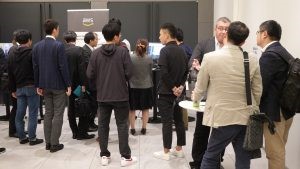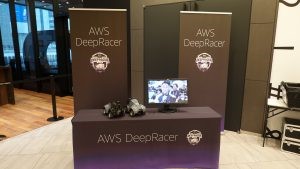AWS for Industries
Event Report: AWS Autotech Forum 2019 in Tokyo, Japan
Hello, I’m Hiroshi Okamoto, a Solutions Architect at Amazon Web Services Japan. This report will explore “AWS Autotech Forum 2019”, an automotive industry event sponsored by AWS and held in Tokyo on October 25, 2019.
Have you ever imagined the combination of AWS and the automotive industry? Actually, AWS services are widely used in many different workloads and initiatives in the automotive industry. Both business leaders and engineers engaged in Mobility as a Service (MaaS), autonomous driving, connected cars, and edge computing were invited to this event to show examples of their latest initiatives leveraging AWS services. In this blog post, I show you the highlights of the speech sessions and demo booths:
Opening session
As an AWS Solutions Architect, I made an opening speech titled “Toward the Enablement of Growing Mobility Services” and highlighted the market trends around MaaS, the theme of this year’s event. While MaaS, which is a business trend, has been drawing more attention, CASE (Connected/Autonomous/Shared/Electric), a technology trend, has also been evolving, and the market is expected to grow significantly in the future. MaaS has two facets: one is an emerging business and the other is a new platform business developed by a business alliance. Although they have different basic technological requirements, you can meet both by leveraging AWS, so that you can focus on your business.
- Basic requirements for an emerging business
- Focus on core competencies
- Bring ideas to life quickly
- Be scalable
- Basic requirements for a business alliance and new platform
- Integrate data securely
- Comply with the Ecological Footprint
- Minimize learning costs (Engineers should use a “common language”)
Additionally, two guest speakers showed their latest initiatives: Shintaro Hirato of Otonomo, an Israeli startup, and Ryuji Wakikawa of MONET Technologies, a market leader promoting MaaS platform in Japan as social infrastructure by collaborating with many Japanese automotive companies.
Breakout sessions
DENSO’s MaaS Development – Overview of Collaboration with Customers, Team Building, and Implementation in Agile Development – DENSO CORPORATION
In this session, Yoshiei Sato and Naomichi Shimazu of Digital Innovation Room at DENSO talked about their “start small” and software-centric agile development methodology. They divided the development process into four phases from prototyping to production, and shared their tips and tricks for each phase in detail. They believe that PoC should avoid ambiguity and clarify things that need to be verified, and that engineers should NOT design architecture or start coding beyond the scope of PoC hoping that they could be used in production later. They also talked about using their manufacturing know-how in the test and production phases, such as manpower-saving and automation.
Creating mobility applications with the Transportation Mobility Cloud (TMC) — Autonomic
Autonomic, an advanced technology partner of AWS, talked about their Transportation Mobility Cloud (TMC). Developing applications that use mobility data involves complexity because they need to perform different operations for different makers and car models. TMC is an open platform that eliminates and abstracts complexity and makes it easy to use mobility data. They explained how TMC provides developer-oriented APIs that help accelerate application development and reduce lead time to market.
Utilizing IoT Technology in Verification Tests of Autonomous Driving Services — Tier Ⅳ, Inc.
Tier Ⅳ, Inc. has been leading development of Autoware, open source software for autonomous driving based on Linux and Robot Operating System (ROS). In this session, Eiji Sekiya, engineer at Tier IV talked about Autoware FMS, an operation management system for autonomous vehicles required to deploy autonomous driving services combined with MaaS. They also showed Autoware Drive, a remote monitoring and control platform for autonomous vehicles. He explained in detail how they utilize AWS IoT Core, a device gateway, and AWS IoT Greengrass, an edge computing platform, not only for communication between vehicles and the cloud but also for facilities like traffic lights. He also showed the architecture diagrams and talked about how they are performing verification tests.
A Deep Dive into Otonomo’s Data Services Platform — Otonomo
Amir Freund, Chief Strategy Officer of Otonomo talked about the features and configuration of their data service platform that processes data from 18 million vehicles. The platform covers vehicle data normalization and aggregation, and complies with regulations such as privacy laws, allowing application providers to focus on service development. To develop a scalable foundation, they leverage many different AWS services such as Amazon S3 for storage, Amazon ECS for application hosting, and Amazon Kinesis Data Streams/Firehose for stream processing, and AWS Lambda. As a result, the platform is capable of processing 2 billion data points per second ingested every day.
From CASE to MaaS — How to Leverage Platform/Data — Amazon Web Services Japan K.K. / Supership Inc.
Shyuhei Takahashi, Business Development Manager for Automotive Industry, AWS, made a speech in the first half of the session. The primary customers of AWS in the automotive industry in Japan used to be start-ups a few years ago, but in recent years more and more car manufacturers and suppliers are leveraging AWS services in the fields of connected vehicles and autonomous driving. These are considered to be cloud-friendly fields because the mindset to start small and improve at short intervals is effective in those fields contrary to the conventional field of vehicle development. That mindset is becoming increasingly important in MaaS, and you need to understand that planning and creating a huge platform in advance won’t move things forward as you expect. As an example at AWS, he showed Amazon’s unique practices such as building a “two-pizza team” to maintain agility of an organization, and “working backwards” initiative to create a customer-oriented PoC. In the second half of the session, Akito Inada and Thomas Yoshihara of Supership Inc. elaborated on how they adopted “Start small and build as you go” strategy when they started data business to accelerate digital transformation (DX).
Navitime Japan’s MaaS Initiatives and Future Development — Navitime Japan
Arata Kikuchi of Navitime Japan talked about their MaaS initiative and future plans. Navitime Japan aims to provide navigation not only for cars and train rides but also for all means of transportation and scenes such as bus, shared bike, and truck. In this session, he showed many different practices such as traffic flow analysis, demand forecasting, behavioral analysis of visitors to Japan, different approaches to different MaaS levels (0 to 4), and personalized route discovery algorithm using AI.
Connected Car Solutions Using AWS IoT Greengrass — Amazon Web Services Japan K.K. / Renesas Electronics Corporation
Yusuke Kawasaki of Renesas Electronics Corporation, an embedded solution provider, talked about their connected car platform and their concept for end-to-end total solutions from cloud services to vehicle control in the autonomous driving era. To support MaaS they found it important to develop software that is independent of hardware differences, as well as to offer ease of maintenance. For the vehicle side, they developed Renesas Connected Car SDK that runs on the R-Car. For the cloud side, they adopted Connected Vehicle Reference Architecture (CVRA) provided by AWS, and they are currently performing verification tests and discussing use cases with the AWS IoT team. Later in the session, Jun Ichikawa, an AWS IoT Specialist, went into detail about CVRA. CVRA is a reference implementation for the backend service of connected cars, and it can be quickly deployed from the template. All features are serverless, such as accumulation of trip information, driver score calculation, anomaly detection in sensor data, and notification. The two core components that comprise CVRA are AWS IoT Core, the device gateway, and AWS IoT Greengrass, which handles offline and edge processing as in-vehicle daemon. Additionally, AWS Lambda is used for business logics, Amazon Kinesis Data Streams is used for stream storage, and Amazon DynamoDB/Amazon S3 are used for data storage.
Demo Booths
Aptpod, Inc., Otonomo, Tier Ⅳ, Inc., GeoSpock, and AWS setup their own demo booths and showcased their services and products. Aptopod’s booth exhibited “intdash Automotive Pro.” It’s a cloud service that quickly visualizes sensor data uploaded to AWS at a higher throughput than MQTT using its proprietary protocol through its in-vehicle terminal. At Otonomo’s booth, their US representatives explained their services in more detail than in the opening session and breakout session. Tier Ⅳ’s booth played a demo movie about Milee, a fully autonomous driving EV company that has been performing verification tests as “One Mile Mobility.” They also displayed Autoware mentioned in their speech session. GeoSpock demonstrated their SaaS that utilizes their proprietary indexing method and can manipulate, search, and visualize diverse and large amounts of geospatial data faster than other former database products. AWS demonstrated a fleet management system created with CVRA and exhibited AWS DeepRacer. CVRA is available for everyone, so please try it out. AWS DeepRacer is a service that includes a 1/18 scale fully self-driving race car powered by Reinforcement Learning (RL) and 3D racing simulator. The championship league will be held at AWS re:Invent 2019 in Las Vegas at the end of November, where winners from virtual circuit races and Summit circuit events all over the world will gather and compete. If you are attending re:Invent, please drop by.


Summary
In this blog post, I reported on the automotive industry’s passion for MaaS and how they are leveraging AWS. AWS will keep supporting transformation of our customers, and will also be posting examples of our customers’ solutions on this blog, so stay tuned! We are also hiring new team members. If you have a passion for supporting the automotive industry with us, please apply.
